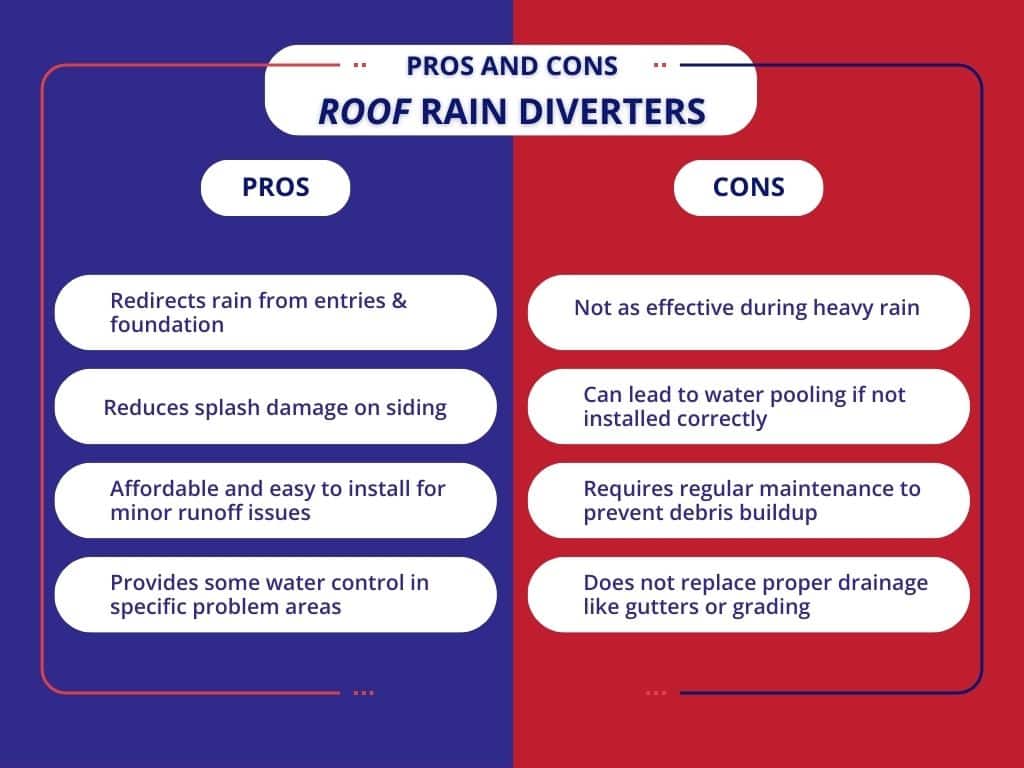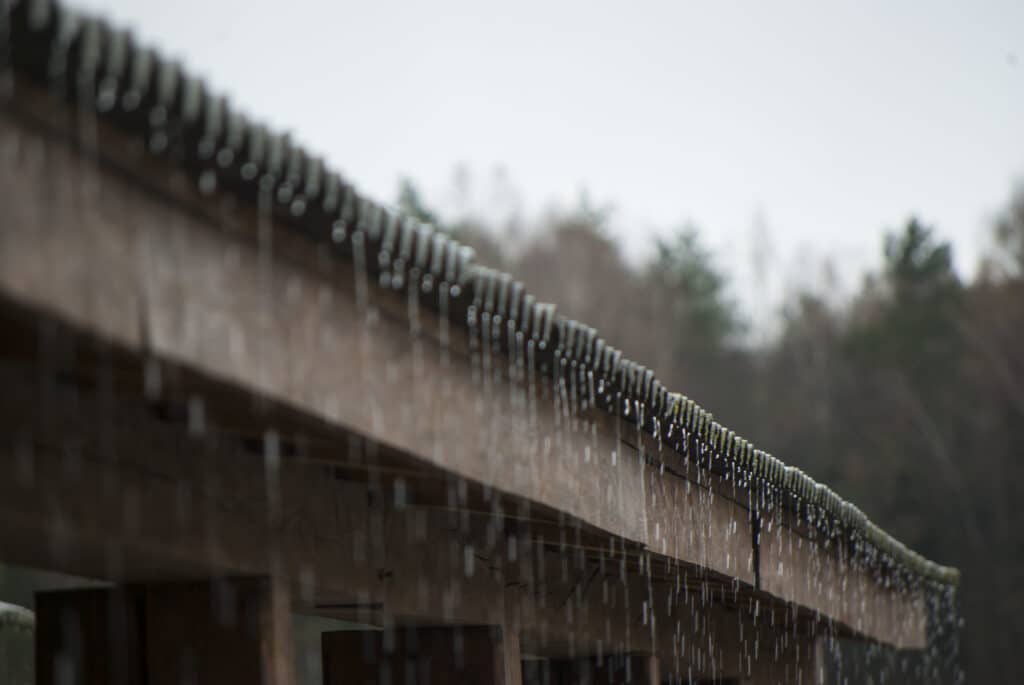When rain pours off your roof, where does it land? If it’s drenching your front steps, splashing against your siding, or creating slick walkways, a roof rain diverter may offer a fix. If you’re unfamiliar, they’re metal strips that redirect rainwater away from high-traffic areas to manage runoff. But are they always the right solution?
While rain diverters can be helpful, they’re not without drawbacks. Poor installation can cause drainage issues, and they don’t replace a full gutter system. This guide breaks the pros and cons of roof rain diverters into a complete list for you so you can see how they compare to other solutions and know when you need a better plan.
How Does a Rain Diverter Work?
A roof rain diverter is metal flashing installed under the edge of shingles. Instead of allowing rain to fall straight down, it channels water to either side, keeping areas like doorways, patios, or garage entrances dry.
Unlike gutters, diverters don’t collect and direct water away from your home entirely. Instead, they shift it elsewhere, which means you still need proper grading and drainage to prevent water from pooling in unwanted areas.
Most rain diverters are made from aluminum or galvanized steel, offering durability against weather exposure. When installed correctly, they can provide a solution for runoff problems, but they’re not designed to handle large amounts of water, especially during heavy storms.

Pros of a Rain Diverter for Your Roof
One of the biggest benefits of a rain diverter is its ability to keep certain areas dry. If you have rain pouring down over a doorway, soaking you every time you step outside, a diverter can be a quick, affordable fix.
It redirects water to the sides, preventing that inconvenient downpour right where you walk. Diverters also help protect doors, windows, and siding from excess moisture. Over time, repeated exposure to rain can lead to wood rot, mold growth, and water stains—especially if your home has wooden siding or trim. A diverter helps minimize direct splash-back damage.
Another advantage is cost-effectiveness. Installing a rain diverter is significantly cheaper than a full gutter system, making it a budget-friendly alternative for homes that only need minor runoff control. They’re often DIY-friendly as well, making them accessible to homeowners who prefer a simple fix.
For homes without gutters, diverters can provide some level of water management. In some cases, homeowners associations (HOAs) restrict gutter installations, and certain architectural styles don’t accommodate them well.
While a diverter isn’t a perfect replacement, it can help mitigate some water-related issues in these situations.
Cons of Using a Roof Rain Diverter
While rain diverters have their benefits, they also come with limitations.
The first major downside is their limited effectiveness in heavy rain. A diverter can only handle so much water at a time. During a storm, excess rain can spill over the edges, leading to unexpected pooling or leaks in other areas.
Improper installation is another concern. If placed incorrectly, a diverter may shift the water problem to another spot, such as near your foundation. Pooling water near the base of your home can lead to structural damage, basement leaks, and costly foundation repairs.
Maintenance is also something to consider. Rain diverters tend to collect debris—leaves, twigs, and dirt can build up behind the metal strip, potentially trapping moisture against the roof. Without regular cleaning, this buildup can cause water to back up, increasing the risk of roof damage.
Finally, diverters are not a substitute for proper drainage. If your home experiences frequent water issues, a diverter alone won’t fix the problem.
It’s a solution for small trouble spots, not a comprehensive rainwater management system.
Alternatives to Roof Rain Diverters
For homeowners facing significant runoff issues, other solutions may be more effective.
Firstly, gutters and downspouts provide the best long-term water control by directing rain away from your home entirely. Properly installed gutters will significantly reduce the risk of foundation damage and water intrusion.
Beyond your primary rainwater management and drainage system, here are some other common solutions to consider:
- Drip edges are a low-maintenance option that helps control water runoff at the roofline without additional cleaning or upkeep.
- Grading and landscaping adjustments can naturally direct water away from your home, preventing pooling near the foundation. A well-graded yard is an essential part of overall drainage management.
- Extending roof overhangs provides another way to minimize water exposure near doors and walkways without adding extra fixtures.

Rain diverter installed on a roof
Other Maintenance to Prevent Water Damage
Even if a rain diverter helps redirect runoff, it’s important to keep an eye on your home’s overall drainage. Small water problems can turn into costly damage if left unchecked.
Start by regularly inspecting your roof and diverters. Look for signs of water pooling near doors, walkways, or the foundation. If you notice standing water, it may indicate that the diverter isn’t directing runoff effectively.
\Cleaning your roof and gutters also helps prevent blockages. Leaves, dirt, and other debris can clog drainage paths, causing overflow. Be sure to check the area behind the diverter, as trapped moisture can weaken the roof’s structure over time.
Also, watch for signs of moisture damage around your siding and door frames. If you see staining, peeling paint, or soft spots in wood trim, water may be seeping in.
When to Get Help With Water Management Issues
A rain diverter might seem like a simple fix, but in some cases, it’s not enough to solve larger drainage problems. If you’re dealing with ongoing water issues, it’s best to get a professional inspection.
Specifically, you should give an expert a call if:
- Water continues to pool around your foundation, increasing the risk of structural damage.
- You notice moisture stains, mold growth, or soft spots on walls, ceilings, or exterior siding.
- Your home doesn’t have proper drainage, such as missing gutters, poor grading, or frequent flooding near entry points.
- You want a long-term solution that will protect your home from future water damage.
According to data collected from real people by Angi, foundation repairs caused by poor drainage can cost anywhere from $2,000 to $15,000. Address runoff issues early to prevent trouble and keep your home structurally sound.
Conclusion
A roof rain diverter can be a useful tool for managing minor runoff problems, but it’s not a complete drainage solution. While it helps keep entryways dry and reduces splash-back damage, it requires regular maintenance and may not be effective in heavy rain.
If you’re noticing persistent drainage issues or moisture damage, or you’re planning to buy or sell a home, it’s time to book an inspection and plan your comprehensive approach upkeep. At Knockout Inspections, we specialize in home inspections and helping you Fortify your home.

